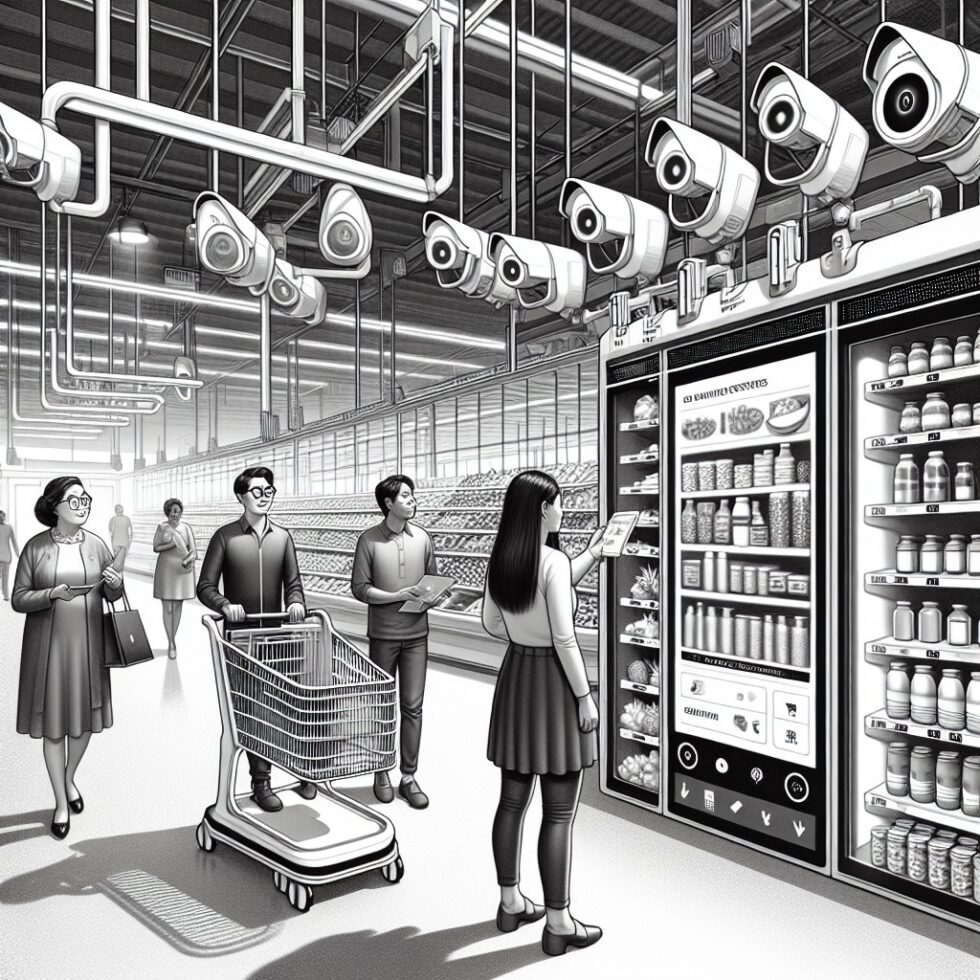
Waiting in line has been a feature of stores for more than a century. That’s changing. Quietly, a new set of tools—smart carts, ceiling cameras, shelf sensors, and hybrid checkout gates—are turning the checkout itself into software. You pick items, walk out, and the system figures out who took what. The promise is simple: less hassle for shoppers and better economics for retailers. The reality is more nuanced. This article breaks down how these systems actually work, what they cost, where they fail, and how to run a practical pilot that you can scale.
The Four Blueprints for Line‑Free Shopping
No single design “wins” everywhere. Different store layouts, basket sizes, budgets, and risk profiles point to different architectures. The main blueprints are below.
1) Ceiling Cameras With Computer Vision
This is the approach most people think of first. A grid of overhead cameras watches every aisle. Software performs three jobs at once: track people in the scene, recognize products, and detect events like pick up, put back, and handoff between shoppers. The system links a shopper to a virtual basket, and charges when that person exits through a gate or a geofenced area.
- Strengths: Hands‑free experience; nothing to carry; can cover an entire small supermarket; minimal hardware on shelves.
- Weaknesses: Heavier compute needs; careful ceiling planning; challenging with reflective surfaces or crowded endcaps; retrofits can be expensive.
- Typical fit: Compact groceries, convenience stores, airport shops, university stores, stadium kiosks.
2) Shelf Weight Sensors
Here, each shelf (or shelf segment) sits on load cells that feel tiny changes in weight. When a hand reaches in, a camera or IR sensor flags the event; the shelf notes the exact delta; software matches that with the product inventory at that location. Because the shelf “knows” the item’s weight and position, recognition is easier.
- Strengths: High accuracy for single‑face SKUs; robust in glare or tight spaces; simpler item recognition.
- Weaknesses: Hardware on every shelf; calibration matters; restocking needs discipline; less flexible for irregular items.
- Typical fit: Beverage coolers, snack walls, specialty kiosks, micromarkets in offices and gyms.
3) Smart Carts
Shopping carts or baskets carry the tech: a camera array, scale, and touch display. Shoppers scan or are recognized as they take a cart. Each item is identified at the cart level as it’s placed in or removed. Payment happens on the cart or at a fast exit lane.
- Strengths: Scales to larger stores; portable; can start with a subset of carts; complements traditional checkout.
- Weaknesses: Battery management; device wear and tear; occasional item rescans; shoppers need to choose a smart cart.
- Typical fit: Mid‑ to large‑format groceries, warehouse clubs, discount retailers.
4) Scan‑and‑Go With Smart Gates
Shoppers scan items with their phone as they shop. When they reach an exit gate, a price and item match is verified—often with a cart‑level scan or brief visual check. It’s the lightest approach: mostly software, signage, and a gate.
- Strengths: Low capex; quick to roll out; familiar for customers; flexible.
- Weaknesses: More friction than pure “walk out”; depends on shopper honesty plus spot checks; not fully hands‑free.
- Typical fit: General merchandise, variety stores, outlets with wide SKU mixes.
Practical tip: Many successful deployments blend approaches—cameras for most aisles, shelf sensors in beverage fridges, and a scan‑and‑go fallback for edge cases like large irregular items.
How the System Knows Who Took What
Behind the scenes, three engines run in concert: identity without biometrics, item recognition with SKU context, and event detection that converts motion into a basket.
People Tracking Without Faces
Modern stores can identify a shopper’s session without face recognition. Systems rely on re‑identification features such as clothing color and texture, body topology, gait hints, and the path taken through the store. A device handshake at entry (app QR, card tap, or gate token) anchors that session to an account. From there, multi‑camera tracking follows the person through occlusions and crowding.
- Occlusions: When someone passes behind a display or another shopper, algorithms carry forward multiple hypotheses for 0.5–2 seconds until the subject reappears.
- Groups: Families shopping together can be tracked as a cluster with multiple baskets, then reconciled by exit behavior: who leaves first, who owns which cart, and which account scans at the gate.
- Privacy practice: Many retailers adopt a “no face templates stored” policy and process video on the edge with short retention windows.
Item Recognition That’s Not Just “See a Can, Guess a Can”
Recognition isn’t only about images. It’s image+context. Shelves are mapped to SKUs by planogram, with frequent audits to account for substitutions and misplacements. Systems use packaging cues (logos, colors, shapes) plus context like shelf position, GS1 Digital Link codes when available, and known weight ranges. In cooler doors or where packages look similar, a short list of candidates is disambiguated by hand pose, angle, and trajectory.
To support new products and seasonal packaging, stores add SKUs by capturing a few dozen reference images and updating expected attributes—size, weight, price, age restrictions, and promotions. The fastest systems push these updates while the store is open, without long retraining cycles.
Events: Pick, Put Back, and Handoff
The hardest part is not seeing objects; it’s knowing what counts. If you pick up two items, put one back, and give one to a friend, the system must attribute each step to the correct basket. Systems do this by combining fine‑grained hand tracking with object trajectories and shelf deltas (camera or weight sensors). At exit, the system compares total expected items to the gate’s short validation—sometimes just a one‑second glance to confirm a large item like a case of water.
Payments and Receipts
Entry usually ties a shopper to a payment method: app QR code, credit card tap at the gate, or a store card. Some systems integrate with the existing POS stack so promotions, loyalty points, and coupons apply as usual. Receipts are sent by email, app, or printed at a kiosk if needed. Returns allow item‑level reversals if the item is re‑shelved within a time window and can be identified in video. Age‑restricted items trigger a staff assist for ID check at pickup or at the gate.
Designing a Store That Computers Can Understand
Accuracy and shopper satisfaction start with the physical space. Think less about “AI magic,” more about lighting, camera angles, power, and good old‑fashioned housekeeping.
Lighting: Flat, Even, No Flicker
LED flicker from cheap drivers can confuse high‑frame‑rate cameras. Use high‑quality drivers and test under your exact fixtures. Avoid deep backlighting that turns shoppers into silhouettes. Matte finishes reduce glare that can wash out labels. In coolers, try anti‑fog doors and position cameras slightly off‑axis to cut reflections.
Camera Placement and Optics
Ceiling cameras work best with overlapping views (20–30% overlap) so every item is seen by at least two cameras. Higher ceilings need narrower lenses; low ceilings need more cameras with wider fields of view. Aim for consistent pixel density across the selling area—don’t starve corners. In smart cart setups, ensure carts can see the basket clearly even when full; raised baskets and angled cameras help.
Networks and Edge Compute
Most systems process video on the premises to keep latency low and protect privacy. Power over Ethernet (PoE) simplifies camera installs. A typical mid‑size store might use dozens of cameras at 3–7 W each, with one to three GPU servers tucked in a back room. Data flows include live video, event metadata, and a trickle of cloud sync for model updates and analytics.
- Latency budgets: Aim for sub‑second event detection; buffering and consensus can add 100–300 ms.
- Resilience: Run on UPS; keep hot spares for key servers; design so you can switch to staffed checkout if the system falters.
- Maintenance: Dust on lenses, bumped cameras, or loose shelf sensors will degrade accuracy—weekly walkthroughs fix most issues.
Accessibility and Clarity
Line‑free should also mean stress‑free. Keep aisles wide, signage direct, and exits obvious. Provide a “help” button or on‑floor associate to resolve questions fast. Wheelchairs, strollers, service animals, and toddlers all change scene dynamics—test with them. Offer a staffed lane for cash or people who opt out. Spell out what data you collect, for how long, and how to get a receipt without an app.
Cost Math You Can Actually Sanity Check
Costs vary by geography and vendor, but you can model them with a few rules of thumb. The big buckets are hardware (cameras, sensors, carts, gates), installation (cabling, ceiling work, network), compute (servers, storage), software (licenses, per‑store or per‑camera fees), and operations (maintenance, training, audit labor).
Ballpark Ranges
- Ceiling camera installs: Small convenience stores may come in at a low six‑figure capex. Larger grocery footprints cost more due to camera count, ceiling work, and compute.
- Shelf sensors: Costs scale with shelf faces. A beverage fridge retrofit might be in the tens of thousands; equipping an entire store adds up fast but delivers high precision on those zones.
- Smart carts: Expect a few thousand per cart, plus charging docks, spares, and maintenance. Rolling out to a subset (e.g., 20–30 carts) limits capex.
- Scan‑and‑go: Lowest hardware cost—often just gates and some scanners—but requires disciplined operations for spot checks.
ROI Drivers
- Throughput: Removing queues increases peak‑hour capacity. In small formats, this can expand effective store size without new rent.
- Labor: Associates spend less time on checkout and more on stocking, service, and fresh counters. The point isn’t fewer people; it’s more useful minutes.
- Basket size: Some retailers report modest lifts because shoppers keep flow and add impulse items. Your mileage will vary with category mix.
- Shrink: Better tracking can deter casual theft and mis‑scans. Remember there’s a learning period; initial shrink may rise if processes are loose.
- Experience: Faster trips can boost loyalty, especially for commuters, parents with kids, and late‑night shoppers.
Reality check: Don’t pencil ROI from “firing the queue.” Savings show up as smoother peaks and more staff time for tasks that grow sales—sampling, helping, keeping shelves full. Build metrics around those outcomes.
Risks and Practical Safeguards
New tech brings new failure modes. Plan for them from day one.
Privacy and Trust
- Minimize data: Process video at the edge; store only short clips for dispute resolution; avoid biometric identifiers.
- Clear notices: Post simple, prominent explanations of how the system works and what data is retained.
- Opt‑outs: Offer a staffed alternative and a way to get a receipt without an app or account.
Fairness and Accessibility
- Diverse testing: Validate performance across skin tones, clothing types, mobility aids, group shopping, and children.
- Lighting reality: Test at dusk, in bad weather light, and with seasonal decorations that change shadows and occlusions.
- Third‑party review: Consider external audits for accuracy and bias; publish results and fixes.
Security and Reliability
- Harden devices: Lock down cameras and carts; monitor for tampering; patch regularly.
- Network design: Isolate video networks; rate‑limit cloud connections; keep a clean break between POS and vision systems.
- Degraded modes: If the system stalls, fall back to staffed checkout instantly; never trap shoppers at a gate.
Customer Support: Fixing the Rare But Memorable Errors
- Dispute flow: Make it one tap to flag a wrong item; show the suspected item photo; resolve quickly with an associate.
- Group logic: Families often split at the exit; make it easy to merge or split receipts after the fact.
- Returns: Support instant refunds if a mistakenly charged item is shown to a kiosk or associate within a set window.
How to Pilot in 90 Days
You don’t need to transform an entire chain to learn. A focused pilot teaches more than endless spreadsheets.
Week 1–2: Define Scope and Success
- Pick the zone: 800–2,500 square feet with a clear entrance/exit and manageable SKU count.
- Choose architecture: Cameras, shelf sensors, carts, or a hybrid. Match it to the zone’s products and traffic.
- Set metrics: Target accuracy (>98% item‑level), average trip time, associate time shifted to higher‑value tasks, and customer satisfaction.
Week 3–6: Prepare the Space
- Upgrade lighting: Fix flicker and glare; verify with vendor test rigs.
- Install hardware: Cameras with PoE, shelf sensors where needed, network switches, and edge servers on UPS.
- Map SKUs: Capture reference images, weights, and GS1 attributes; clean up planograms.
- Train associates: How to help at entry, resolve disputes, and maintain equipment.
Week 7–8: Soft Launch
- Invite staff and loyalty members: Gather feedback fast; watch for choke points.
- Instrument everything: Event accuracy, misattributions, help requests, and exit flow times.
Week 9–12: Open and Iterate
- Public launch: Clear signage, quick demos, and a friendly on‑floor guide.
- Fix the details: Reposition cameras that drift, tighten shelf restock routines, tune thresholds for pick/put events.
- Report results: Share metrics with stakeholders; decide on expansion, changes, or a different architecture.
What Changes for Shoppers and Staff
Line‑free stores change the rhythm of a trip. For shoppers, entrance and exit become the only moments to think about “checkout.” For staff, less time on scanning means more time on service and in‑aisle tasks.
For Shoppers
- Discovery feels lighter: No line pressure; browsing is easier.
- Payment is backgrounded: Tap at entry or scan once; receipts arrive automatically.
- Control matters: Provide a cart or app view of the running basket so people can see totals and promotions while they shop.
For Staff
- New roles: Floor concierge, system steward, and in‑aisle educator replace some checkout time.
- Skills shift: Light tech maintenance, great people skills, and fast exception handling matter more than speed at a scanner.
- Pride in place: When queues vanish, associates get to shape a store’s vibe and standards. That shows up in sales.
Choosing Vendors Without the Hype
Ask each vendor to run against your reality—not a staged demo.
- Bring your SKUs: Seasonal packs, near‑identical flavors, bar‑coded bakery clamshells, and anything shiny or transparent.
- Stress the system: Groups of five, kids in motion, shoppers in hats, and a few edge cases like swapping identical items between two people.
- Demand audits: Request per‑SKU accuracy reports, failure breakdowns, and raw event logs for a sample day.
- Check exit experience: How often do people get stopped? What’s the median time at the gate? What if someone forgot to tap in?
- Clarify data policies: Edge processing, retention windows, and the ability to purge on request.
What Comes Next
As costs fall and models improve, line‑free will move from specialty zones to whole formats. Expect hybrid layouts—areas where you linger and sample, zones where you grab and go, and carts that make a weekly shop smoother. Standards like GS1 Digital Link will help tech recognize products more reliably. The boring plumbing—good lighting, simple signage, and disciplined restocking—will matter as much as any algorithm. The winners won’t be the flashiest demos. They’ll be the stores where the tech fades into the background and shopping simply feels effortless.
Summary:
- Four main architectures deliver line‑free shopping: ceiling cameras, shelf sensors, smart carts, and scan‑and‑go gates.
- Systems identify sessions without biometrics, using entry tokens and re‑identification across cameras.
- Item recognition blends images with shelf context, SKU data, weight ranges, and planograms.
- Store design matters: reliable lighting, careful camera placement, PoE networking, and edge compute for low latency.
- ROI comes from throughput, staff time reallocated to service, and loyalty—less from raw headcount reductions.
- Plan for privacy, fairness, and reliability with clear policies, audits, and instant fallbacks.
- A 90‑day pilot can validate accuracy, experience, and operations before scaling.
- Success depends on the unglamorous details—clean lenses, tidy shelves, clear signage—more than on buzzwords.





